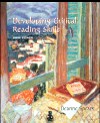 |  Developing Critical Reading Skills, 6/e Deanne Spears,
City College of San Francisco
Exercises
Online Exercises- 1. Is it really true that no two snowflakes are identical? On pages 79 -
80, Collen Murphy disputes this claim, which most of us have undoubtedly believed
since we were in elementary school. Yet the evidence he cites dates from photographs
published in 1885 by Wilson "Snowflake" Bentley. What scientific
investigations have been done more recently to prove or disprove this claim?
Here are four websites on the subject. Which provides the most up-to-date
and complete information? (Note: The first one includes some photographs taken
by Bentley, which are interesting to compare to recent photographs taken with
more sophisticated equipment.)
http://students.sunysuffolk.edu/~giacm11/index5.htm
www.its.caltech.edu/~atomic/snowcrystals/photos/photos.htm
www.earthsky.com/2001/es010114.html
www.bogle-dw.freeserve.co.uk/mtmy01.htm
- Jan Yoors, author of The Gypsies, had a fascinating life. (See the excerpt
from his book on page 84.) Yoors developed an early fascination with the Belgian
Lowara band of Gypsies with whom he lived as a teenager for several months
each year. Later, during World War II, he helped save many Gypsies from being
sent to the Nazi extermination camps. The following website examines Yoors'
unusual life after he moved to the United States: www.metropolismag.com/html/content_0601/yoo/.
- On page 86, Diane Ackerman describes the tingly sensations diners experience
eating fugu, or Japanese puffer fish. Experienced chefs prepare fugu by leaving
in the tiniest sliver of poisonous flesh, thus providing the diner with what
Ackerman calls a "brush with mortality." The following website includes
photographs, discusses various dishes made from the puffer fish, provides
related links, and has a discussion board devoted to "Dangerous Japanese
Food." The address is
http://japanesefood.about.com/library/weekly/aa020501a.htm.
Explore some of these related links. Based on your findings, what are some
reasons dangerous foods appeal to people? Would you try fugu if given the
chance?
- For a slightly more ambitious project in making inferences, go to three
well-known search engines. Some examples are yahoo.com,
altavista.com, google.com,
netscape.com, or directhit.com.
Type in a common ailment of your choosing, for example, insomnia or migraine
or acne. Study the first ten listings each site brings up. What inferences
can you draw about the criteria each search engine uses to identify the ten
most usable sites? How many of these first sites are commercial? How many
appear to offer more reliable or objective medical information?
|
|



 2003 McGraw-Hill Higher Education
2003 McGraw-Hill Higher Education